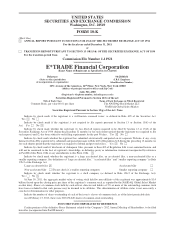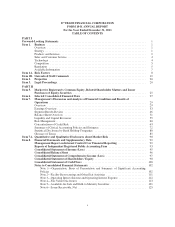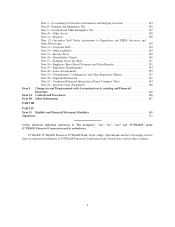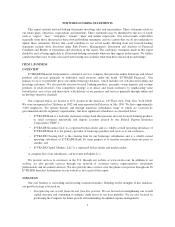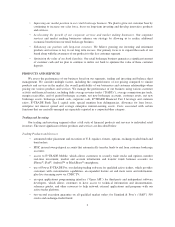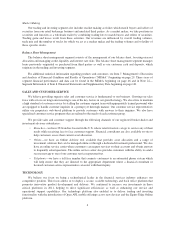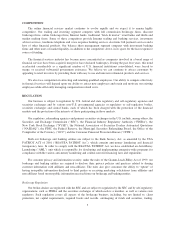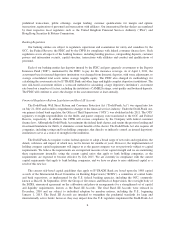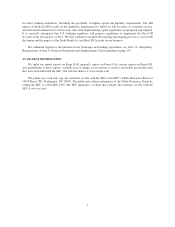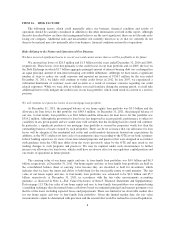eTrade 2011 Annual Report Download - page 11
Download and view the complete annual report
Please find page 11 of the 2011 eTrade annual report below. You can navigate through the pages in the report by either clicking on the pages listed below, or by using the keyword search tool below to find specific information within the annual report.ITEM 1A. RISK FACTORS
The following factors which could materially affect our business, financial condition and results of
operations should be carefully considered in addition to the other information set forth in this report. Although
the risks described below are those that management believes are the most significant, these are not the only risks
facing our company. Additional risks and uncertainties not currently known to us or that we currently do not
deem to be material may also materially affect our business, financial condition and results of operations.
Risks Relating to the Nature and Operation of Our Business
We have incurred significant losses in recent years and cannot assure that we will be profitable in the future.
We incurred net losses of $28.5 million and $1.3 billion for the years ended December 31, 2010 and 2009,
respectively. These losses were due primarily to the credit losses in our loan portfolio and, in 2009, the loss on
the Debt Exchange in which $1.7 billion aggregate principal amount of interest-bearing debt was exchanged for
an equal principal amount of non-interest-bearing convertible debentures. Although we have taken a significant
number of steps to reduce our credit exposure and reported net income of $156.7 million for the year ended
December 31, 2011, we likely will continue to suffer credit losses in 2012. In late 2007, we experienced a
substantial diminution of customer assets and accounts as a result of customer concerns regarding our credit
related exposures. While we were able to stabilize our retail franchise during the ensuing period, it could take
additional time to fully mitigate the credit issues in our loan portfolio, which could result in a return to a net loss
position.
We will continue to experience losses in our mortgage loan portfolio.
At December 31, 2011, the principal balance of our home equity loan portfolio was $5.3 billion and the
allowance for loan losses for this portfolio was $463.3 million. At December 31, 2011, the principal balance of
our one- to four-family loan portfolio was $6.6 billion and the allowance for loan losses for this portfolio was
$314.2 million. Although the provision for loan losses has improved in recent periods, performance is subject to
variability in any given quarter and we cannot state with certainty that the declining loan loss trend will continue.
In particular, a significant portion of our mortgage loan portfolio is secured by properties worth less than the
outstanding balance of loans secured by such properties. There can be no assurance that our allowance for loan
losses will be adequate if the residential real estate and credit markets deteriorate beyond our expectations. In
addition, as the OCC conducts its first cycle of examinations since succeeding to the OTS as our bank’s primary
federal banking supervisor, its views of our loan-related programs and practices that were designed in accordance
with guidance from the OTS may differ from the views previously taken by the OTS and may result in our
making changes to such programs and practices. We may be required under such circumstances to further
increase our allowance for loan losses, which could have an adverse effect on our regulatory capital position and
our results of operations in future periods.
The carrying value of our home equity and one- to four-family loan portfolios was $4.9 billion and $6.3
billion, respectively, at December 31, 2011. Our home equity and one- to four-family loan portfolios are held on
the consolidated balance sheet at carrying value because they are classified as held for investment, which
indicates that we have the intent and ability to hold them for the foreseeable future or until maturity. The fair
value of our home equity and one- to four-family loan portfolios was estimated to be $4.3 billion and $5.7
billion, respectively, at December 31, 2011, in accordance with the fair value measurements accounting
guidance, as disclosed in Note 4—Fair Value Disclosures of Item 8. Financial Statements and Supplementary
Data on page 113. The fair value of our home equity and one- to four-family loan portfolios was estimated using
a modeling technique that discounted future cash flows based on estimated principal and interest payments over
the life of the loans, including expected losses and prepayments. There was limited or no observable market data
for our home equity and one- to four-family loan portfolios. Given the limited market data, the fair value
measurements cannot be determined with precision and the amount that would be realized in a forced liquidation,
8

